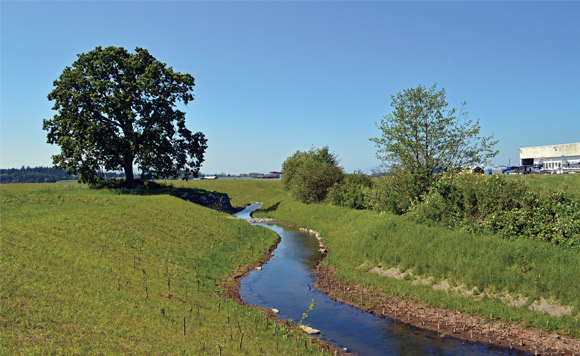by Jo Barnes –
Jet lag. Economy class. Grounded airplane.
While some terms associated with flying may appear incongruous, there is one aviation oxymoron that might actually be possible: a green airport.
While many say the aviation industry has an adverse impact on the environment, the Victoria Airport Authority (VAA) definitely has taken significant steps towards being greener and more environmentally proactive. For many years now the VAA has shown itself to be a leader in environmental management and responsible steward of the lands around it.
“It’s the right thing to do and it makes a huge difference to our local ecosystem,” says James Bogusz, Vice-President Operations & Development, Victoria Airport Authority (VAA).
In 2005 to 2006 assessment and water testing was done at Reay Creek, which flows southeast into Bazan Bay. Systematic outflow testing was done in 2010 to detect the source of pollution for stormwater entering Reay Creek. VAA subsequently began a massive creek remediation project in 2012 at a cost of $232,000. A 200-metre-long diversion channel was created, incorporating fish habitat features and introducing manual water gates for emergency events such as spills.
“We have seen a huge decrease in heavy metal pollution levels in our downstream testing station. We continue to see that decline and expect that to continue in years to come,” says James.
Along the west side of the airport is another waterway, TenTen Creek, which also attracted the VAA’s attention. A stormwater catchment complex was built in 2000 to treat the water from nearby farming operations. Dump sites dating back to World War II had been leaching into the creek, portions of the storm drain system were damaged and iron was being released into the water. VAA began a project to improve the facilities and water treatment systems. A diversion channel was built to direct pond water into an irrigation retention area and to reduce sediment and stormwater into the creek. The project included repairing the banks of the stream and restoring habitat. When three-spined stickleback and juvenile sea-run cutthroat trout were discovered in 2012, it became clear that intervention to reduce harmful pollutants and restore the creek ecosystem makes a difference.
Then in 2016 came the TenTen Sediment Reduction Project, which included removing garbage from dump sites, strengthening dumpsite banks to reduce any future erosion, building traps to reduce sediment load into the Patricia Bay waters, and encouraging aquatic habitat by enhancing creek plantings.
These projects are the result of teamwork involving Transport Canada, Department of Fisheries and Oceans and Tseycum First Nation as well as local groups like Peninsula Streams Society, Shorekeepers, and Sidney Anglers.
In 2013 VAA received the ACI Environmental Achievement Award for Mitigation and the BC Aviation Council Silver Wings Environmental Award. But the biggest pay off has been what’s happening at Reay and TenTen. Healthy fish are returning and plants are thriving. “We have been seeing the return of cutthroat trout which shows that there have been improvements to the health of the creek,” says James.
This year another $650,000 will be invested towards Reay Creek, focusing on a detention pond and sediment trap near the airport property line which will help to protect the creek and manage stormwater flows. Say James: “VAA is the only airport I know of in our size category who has made these large investments in stream and habitat restoration.”
VAA’s efforts extend beyond the waterways to the wildlife which it monitors regularly. Initiatives include mitigating pollution, applying techniques to discourage birds from feeding in high risk zones, maintaining fencing to protect from predators, and protecting habitat. It’s all part of the VAA’s overall commitment towards excellence in environmental stewardship, including significant initiatives towards minimizing its carbon footprint.
“We were the third airport in North America to receive Airport Carbon Accreditation,” says James.
A member of Airports Council International (ACI), VAA has set a target of 5% reduction in greenhouse emissions on a per-square-metre basis by 2019.
As VAA looks ahead to future expansion projects, it does so with a detailed assessment program in place including environmental screening, construction monitoring, soil testing and close liaison with local First Nations who monitor any excavations of airport land to ensure protection of archaeological artifacts.
“I am proud to work for a company that is so supportive of going well outside of its obligations and steps up to give the environment a helping hand,” shares James.
Demonstrating environmental stewardship is the mandate of VAA. It means commitment, focused effort, and never being content to rest on your laurels. Because when it comes to environmental responsibility, you have to follow another oxymoron: change is really the only constant.
Photo of Reay Creek courtesy Alessandro Roethel.




